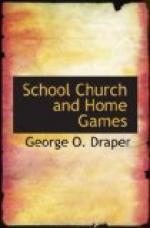Seeing and Remembering
Fifteen or twenty articles are placed upon a table under a sheet, in front of the pupils. The sheet is removed for a space of 10 seconds and the pupils are given a good chance to study the articles on the table. After the sheet has again covered the articles, each pupil is requested to write as many of the articles as can be remembered, on a sheet of paper. The one remembering the largest number wins.
Definitions
The teacher selects some word from the dictionary, which is written upon the blackboard. Each pupil then writes the definition of that word on a slip of paper. After this is done, the teacher compares the definition with that in the dictionary. The one giving the definition nearest like that in the dictionary wins, and gives the next word to be defined.
Jumbled Words
The pupils of each aisle constitute a team. Each pupil in the aisle is given a number. The one in each front seat is Number 1, the one behind him Number 2, and so on back. The teacher has prepared a different sentence for each aisle with just as many words in it as there are pupils in the aisle. One of these slips is handed to Number 1 of each team. Number 1 takes the first word of the sentence as his word, Number 2 the second, Number 3 the third, and so on. When the last one in the aisle has learned the last word in the sentence, the slips are returned to the teacher. Competition can be added to this phase of the game by seeing which aisle can return the slip to the teacher first.
When the slips have all been turned in, the teacher calls any number. Thereupon the pupils in each aisle having that number, go to the blackboard and write distinctly their word from the sentence. For example, the teacher calls Number 3. Number 3 of aisle 1 had the word “money”; Number 3 of aisle 2 “can,” etc.
Next the teacher calls Number 5. All the Number 5’s go to the blackboard and write their words directly after those written by their previous team mate. When all the numbers have been called there is a jumbled sentence on the board for each aisle. The pupils of the various aisles then try to guess what the sentences of the other aisles are. Each one guessed, counts 5 points.
Descriptive Adjectives
An historical personage is selected, such as Columbus, George Washington, etc. The first pupil called upon must describe the subject with a descriptive adjective beginning with “A”. The second, third, and fourth, etc., adding to this description by using adjectives beginning with the letter “A”. This continues until the adjectives beginning with the letter “A” have been exhausted. Then the letter “B” is used and the game continues. It is well to change the subject after every fourth or fifth letter. This is a good game for adding to the vocabulary of the pupil. A little fun can be had by using, instead of an historical subject, one of the pupils of the room for description.




